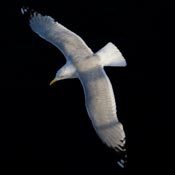Gull Biology and Control methods

Herring gull
Gulls (Laridae) especially Herring and Black-Backed gulls are associated with coastal areas. Other Gull species can be found inland. Gulls are usually white with grey / black markings. Young birds are brown speckled and gradually acquire adult feathers.
Five Gull species can be found in the United Kingdom:
- Common gull (Larus canus)
- Herring gull (Larus argentatus)
- Black headed gull (Chroicocephalus ridibundus)
- Lesser black backed gull (Larus fuscus)
- Great black backed gull (Larus marinus)
Most Gull species, with the exception of the Lesser Black Backed Gull are protected species under the Wildlife and Countryside act 1981. Eggs and nests of the Herring gull may be destroyed, but the animal itself is protected. Nest / egg destruction can reduce the colony size , but this method is a long-term approach and might not be very effective in the short term. It is also very labour intensive.
Scaring tactics are generally not very effective, as gulls quickly become accustomed to this deterrent method. The use of live predator birds however is a solid deterrent method if used on a frequent basis.
Shooting can deter a Gull population for considerable time but should be repeated on a regular basis for maximum effect.
Proofing is usually the preferred option to deter gulls permanently. They include spike systems, daddy-long legs, the installation of horizontal steel wire on ledges of buildings and the exclusion of gulls using 75 mm mesh netting.
